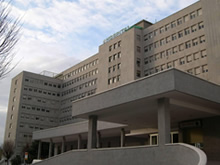Granada
In 2001, a recruitment of pregnant women for a cohort was started in the Clinical Hospital of Granada and the Hospital of the West of Almeria, with the intention to study the relevance of malformations in the masculine genitourinary tract in new born children.
The objective was to try to demonstrate that there is a relation between the chronic exposure of the mother to environmental chemical compounds with hormonal activity, “endocrine disruptors” and the frequency of cryptorchidism and hypospadias in the descendants.
That is why approximately 700 women who had given birth to male children were recruited, 50 of them where indexed with cryptorchidism and/or hypospadias. In a parallel way, a case-control study was begun with 150 new born children with intervention in the diet during the pregnancy (supplement of folic acid to the mothers).
The cohort of mother and children is providing very useful information on the maternal-infantile exposure to chemical compounds with hormonal activity. The studies that already have begun have been useful to show the existing importance of the maternal exposure and regional differences with other European countries. The additional use of exposure markers is being a key issue in the characterisation of the interactions between chemical compounds and the resulting hormonal effect.
-
Collaborating Entities:
Search
Air pollutant exposure during pregnancy and fetal and early childhood development. Research protocol of the INMA (Childhood and Environment Project)
Esplugues A, Fernández-Patier R, Aguilera I, Iñíguez C, García Dos Santos S, Aguirre Alfaro A, Lacasaña M, Estarlich M, Grimalt JO, Fernández M, Rebagliato M, Sala M, Tardón A, Torrent M, Martínez MD, Ribas-Fitó N, Sunyer J, Ballester F. Air pollutant exposure during pregnancy and fetal and early childhood development. Research protocol of the INMA (Childhood and Environment Project). Gac Sanit. 2007;21(2):162-71. Spanish. PMID: 17419934
Efectos de la exposición prenatal a contaminantes ambientales y de la dieta materna en el neurodesarrollo. La Red de investigación ‘Infancia y Medio Ambiente’ (Red INMA)
Rebagliato M, Ballester F, Ramon RM, Marco A. The effects of prenatal exposure to environmental pollutants and the mother’s diet on neurodevelopment. The ‘Infancy and Environment’ Research Network (INMA Network). Rev Neurol. 2007 21;44 Suppl 3:S15-8. Spanish. PMID: 17523104
Human exposure to endocrine-disrupting chemicals and prenatal risk factors for cryptorchidism and hypospadias: a nested case-control study
Fernandez MF, Olmos B, Granada A, López-Espinosa MJ, Molina-Molina JM, Fernandez JM, Cruz M, Olea-Serrano F, Olea N. Human exposure to endocrine-disrupting chemicals and prenatal risk factors for cryptorchidism and hypospadias: a nested case-control study. Environ Health Perspect. 2007;115 Suppl 1:8-14. PMID: 18174944
Biomonitoring of environmental estrogens in human tissues
Fernandez MF, Molina-Molina JM, Lopez-Espinosa MJ, Freire C, Campoy C, Ibarluzea J, Torne P, Pedraza V, Olea N. Biomonitoring of environmental estrogens in human tissues. Int J Hyg Environ Health. 2007;210(3-4):429-32. Epub 2007 Feb 12. PMID: 17296326
Organochlorine pesticides in placentas from Southern Spain and some related factors
Lopez-Espinosa MJ, Granada A, Carreno J, Salvatierra M, Olea-Serrano F, Olea N. Organochlorine pesticides in placentas from Southern Spain and some related factors. Placenta. 2007;28(7):631-8. Epub 2006 Nov 15.PMID: 17109956
Measurement of drinking water contaminants and water use activities during pregnancy in a cohort study in Spain
Villanueva CM, Grimalt JO, Ballester F, Ibarluzea J, Sala M, Tardón A, Romero-Aliaga E, Fernández M, Ribas-Fitó N, Kogevinas M. Measurement of drinking water contaminants and water use activities during pregnancy in a cohort study in Spain. Gac Sanit. 2006;20 Suppl 3:1-9. Spanish. PMID: 17433195
Child health and the environment: the INMA Spanish Study
Ribas-Fitó N, Ramón R, Ballester F, Grimalt J, Marco A, Olea N, Posada M, Rebagliato M, Tardón A, Torrent M, Sunyer J. Child health and the environment: the INMA Spanish Study. Paediatr Perinat Epidemiol. 2006;20(5):403-10. PMID: 16911019
Environmental and lifestyle factors for organochlorine exposure among women living in Southern Spain
Cerrillo I, Olea-Serrano MF, Ibarluzea J, Exposito J, Torne P, Laguna J, Pedraza V, Olea N. Environmental and lifestyle factors for organochlorine exposure among women living in Southern Spain. Chemosphere. 2006;62(11):1917-24. PMID: 16153679
Endosulfan and its metabolites in fértiles women, placenta, cord blood, and human milk
Cerrillo I, Granada A, López-Espinosa MJ, Olmos B, Jiménez M, Caño A, Olea N, Fátima Olea-Serrano M. Endosulfan and its metabolites in fertile women, placenta, cord blood, and human milk. Environ Res. 2005;98(2):233-9. PMID: 15820730
The Environment and Childhood Research Network (“INMA” network): study protocol
Ramón R, Ballester F, Rebagliato M, Ribas N, Torrent M, Fernández M, Sala M, Tardón A, Marco A, Posada M, Grimalt J, Sunyer J; Red INMA. The Environment and Childhood Research Network (“INMA” network): study protocol.Rev Esp Salud Publica. 2005 Mar-Apr;79(2):203-20. Spanish. PMID: 15913055
10 / 10



